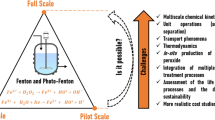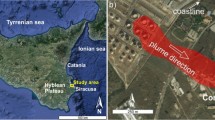Abstract
To estimate the behavior of ethanol-blended dissolved BTEX hydrocarbons in groundwater, a quantitative tracing study instead of qualitative analysis was carried out by using a large sand tank, into which 2-L solution including bromide, ethanol and dissolved BTEX was injected under a controlled hydraulic condition. Mean residence time (MRT), pore volume swept by solute (V p), retardation coefficient (R) and biodegradation rate constant (k) of injected solutes were estimated. Compared with bromide that was used as a conservative tracer, ethanol and BTEX had shorter MRT and smaller V p with the sequence of EtOH < T < E < m/p-X < o-X < B < Br. Biodegradation was confirmed as evidenced by the consumptions of dissolved oxygen (DO), nitrate and sulfate, and the production of acetate. The sequence of k as EtOH > T > E > m/p-X > o-X > B was just opposite to the sequences of MRT and V p. The relationship among above sequences implies that MRT and V p can be used as indicators to assess in situ biodegradability of a solute. Biodegradation of a reactive solute can make its MRT shortened and V p shrunk. In addition, the sorption of ethanol could be neglected (R = 1.0), whereas BTEX compounds were adsorbed (R = 1.04–1.15). It should be noted that biodegradation of a solute can affect the estimation of its retardation coefficient. To our knowledge, this paper provides an available route to quantitatively estimate biodegradability of a solute in groundwater.




Similar content being viewed by others
References
Chen YD, Barker JF, Gui L (2008) A strategy for aromatic hydrocarbon bioremediation under anaerobic conditions and the impacts of ethanol: a microcosm study. J Contam Hydrol 96:17–31
Chen YD, Gui L, Barker JF, Jiang YP (2009) Biodegradability of trimethyl-benzene isomers under the strictly anaerobic conditions in groundwater contaminated by gasoline. Environ Geol 56:1123–1128
Corseuil HX, Hunt CS, Dos Santos RCF, Alvarez PJJ (1998) The influence of the gasoline oxygenate ethanol on aerobic and anaerobic BTX biodegradation. Water Res 32:2065–2072
Da Silva MLB, Alvarez PJJ (2002) Effects of ethanol versus MTBE on benzene, toluene, ethylbenzene, and xylene natural attenuation in aquifer columns. J Environ Eng 128:862–867
Deeb RA, Sharp JO, Stocking A, McDonald S, West KA, Laugier M, Alvarez PJJ, Kavanaugh MC, Alvarez-Cohen L (2002) Impact of ethanol on benzene plume lengths: microbial and modeling studies. J Environ Eng 128:868–875
Garoma T, Skidmore L (2011) Modeling the influence of ethanol on the adsorption and desorption of selected BTEX compounds on bentonite and kaolin. J Environ Sci 23(11):1865–1872
Gomez DE, Alvarez PJJ (2009) Modeling the natural attenuation of benzene in groundwater impacted by ethanol-blended fuels: effect of ethanol content on the lifespan and maximum length of benzene plumes. Water Resour Res 45:W03409. doi:10.1029/2008WR007159
Govindaraju RS, Das BS (2007) Moment analysis for subsurface hydrologic applications. Springer, Netherlands
Juliana GF, Fletcher B, Aravena R, Barker JF (2010) Methane production and isotopic fingerprinting in ethanol fuel contaminated sites. Ground Water 48(6):844–857
Juliana GF, Mocanu MT, Zoby JLG, Molson JW, Barker JF (2011) Migration and fate of ethanol-enhanced gasoline in groundwater: a modelling analysis of a field experiment. J Contam Hydrol 119:25–43
Mackay DM, De Sieyes NR, Einarson MD, Feris KP, Pappas AA, Wood IA, Jacobson L, Justice LG, Noske MN, Scow KM, Wilson JT (2006) Impact of ethanol on the natural attenuation of benzene, toluene, and o-xylene in a normally sulfate-reducing aquifer. Environ Sci Tech 40:6123–6130
Molson JW, Barker JF, Frind EO, Schirmer M (2002) Modeling the impact of ethanol on the persistence of benzene in gasoline-contaminated groundwater. Water Resour Res 38(1):1003. doi:10.1029/2001WR000589
Molson JW, Mocanu MT, Barker JF (2008) Numerical analysis of buoyancy effects during the dissolution and transport of oxygenated gasoline in groundwater. Water Resource Res 44:W07418. doi:10.1029/2007WR006337
Pang L, Goltz M, Close M (2003) Application of the method of temporal moments to interpret solute transport with sorption and degradation. J Contam Hydrol 60:123–134
Pope GA, Jin M, Dwarakanath V, Rouse B, Sepehrnoori K (1994) Partitioning tracer tests to characterize organic contaminants. In: Proceedings of the second tracer workshop, Center for Petroleum and Geosystems Engineering, The University of Texas at Austin, pp 14–15
Powers SE, Hunt CS, Heermann SE, Corseuil HX, Rice D, Alvarez PJJ (2001) The transport and fate of ethanol and BTEX in groundwater contaminated by gasohol. Cri Rev Environ Sci Tech 31(1):79–123
Ruiz-Aguilar GML, Fernandez-Sanchez JM, Kane SR, Kim D, Alvarez PJJ (2002) Effect of ethanol and methyl-tert-butyl ether on monoaromatic hydrocarbon biodegradation: response variability for different aquifer materials under various electron-accepting conditions. Environ Toxi Chem 21:2631–2639
Schaefer CE, Yang X, Pelz O, Tsao DT, Streger SH, Steffan RJ (2010a) Anaerobic biodegradation of iso-butanol and ethanol and their relative effects on BTEX biodegradation in aquifer materials. Chemosphere 81:1111–1117
Schaefer CE, Yan X, Pelz O, Tsao DT, Streger SH, Steffan RJ (2010b) Aerobic biodegradation of iso-butanol and ethanol and their relative effects on BTEX biodegradation in aquifer materials. Chemosphere 81:1104–1110
Shook GM, Forsmann JH (2005) Tracer interpretation using temporal moments on a spreadsheet. Prepared for the U.S. Department of Energy Assistant Secretary for Energy Efficiency and Renewable Energy Contract DE-AC07-05ID14517
Wiedemeier TH, Wilson JH, Kampbell DH (1999) Technical protocol for implementing intrinsic remediation with long-term monitoring for natural attenuation of fuel contamination dissolved in groundwater, vol 1. Air Force Center for Environmental Excellence, Technology Transfer Division Brooks AFB, San Antonio, TX
Zhang Y, Khan IA, Chen XH, Spalding RF (2006) Transport and degradation of ethanol in groundwater. J Contam Hydrol 82:183–194
Acknowledgments
This study was funded by the National Natural Science Foundation of China (41172229, 40672200) and the Natural Science Foundation of Guangxi Innovation Team (GXNSFF018003-7).
Author information
Authors and Affiliations
Corresponding author
Rights and permissions
About this article
Cite this article
Chen, Y., Jiang, Y., Zhu, Y. et al. Fate and transport of ethanol-blended dissolved BTEX hydrocarbons: a quantitative tracing study of a sand tank experiment. Environ Earth Sci 70, 49–56 (2013). https://doi.org/10.1007/s12665-012-2102-4
Received:
Accepted:
Published:
Issue Date:
DOI: https://doi.org/10.1007/s12665-012-2102-4




